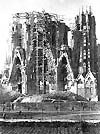 |
 |
 |
 |
 |
 |
 |
 |
 |
|
| ||||||||
 |
 |
 |
 |
 |
 |
 |
 |
 |
|
| ||||||||

Aerial view of the S.F. at the beginings of XX century |
T
he
"S
agrada
F
amília"
The Nativity Façade is the façade of Hope, and upon it Gaudí desired to place a great quantity of sculptures as a splendorous compliment to the architecture. A careful examination of the Nativity Façade allows one to find upon it almost 100 plant species and the same amount of animal species, sculpturally represented in its archivolts. This façade includes three doors dedicated to Faith, Hope and Charity. All the names of Christ's genealogy are engraved on the column above the center door (representing Charity); the serpent with the apple may be found at the base; and the culmination of the baby Jesus is engraved on the door, along with the ox and the mule. The groups of the Adoration of the Magi and the signs of the zodiac as they were on the day of the birth of Jesus also appear on this door. The rest of the façade will include different episodes of the childhood of Jesus, and mysteries such as the Holy Trinity and the Immaculate Conception. In order to see all the details of the models that he needed in order to make the sculptures he used a system of two mirrors joined with a hinge, which allowed him to see various planes in one figure. Thus, upon finding the position which he considered most appropriate, an empty plaster mold was made, from which one solid piece was later sculpted in stone. He also studied the human body and its movements with the help of skeletons (he had two: one natural and another metallic skeleton at one-fifth the natural size); he used their joints in order to study the most adequate positions. The towers of the Nativity Façade begin in the shape of a square and at a certain height become circular. The first was completed in 1918, and the set of four was finished in 1926 with the coronation which represents a cypress, symbol of endurance of time. The towers are finished off with a mosaic appliquÈ which represents the pastoral ring, the staff and the miter of the bishop. Gaudí chose this type of appliquÈ because, due to the difficulty of repairing parts at such great heights, it was preferable to choose a durable material, such as the venetian. The Passion Façade is found in the opposite side from the Nativity, and has more marked and hard lines, which represent the pain and final sacrifice of the life of Jesus. The crucified Christ presides over the central door, and around him are those who were present at his agony: the holy women, Longinos, the Good Thief, at one side, and the soldiers which mock him and the Evil Thief, on the other. Three Latin words appear on this facade: Veritas, Vida and Via, because Jesus is the Way. The studies for this façade were completed between 1892 and 1917, but its construction did not begin until 1952, being completed in 1978.
On the main façade, still under construction, the life and end of man will be explained. Halfway up human life will be represented with the attributes of all manual vocations, presided by St. Joseph in his workshop, and below, the figures of Adam and Eve, who with their fall forced man to work as punishment. Purgatory, death and Hell, as well as the attributes of the Passion, seven angels as an allegory of the Last Judgment, and above all, the Eternal Father, accompanied by angels and the days of Creation, will also be represented. On the portico there will be seven doors, each dedicated to a sacrament and a petition of the "Our Father."
|